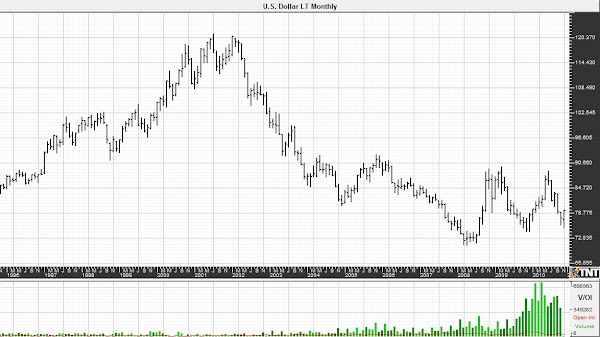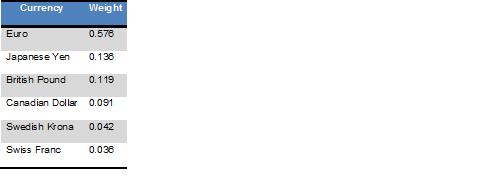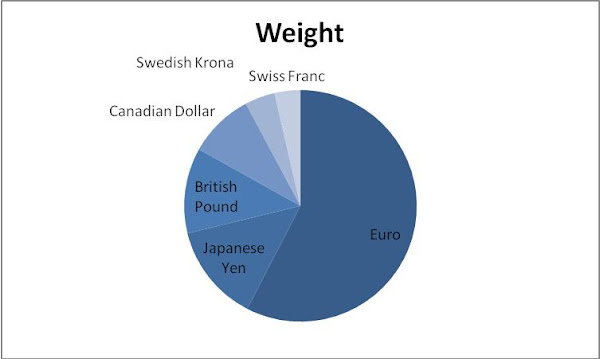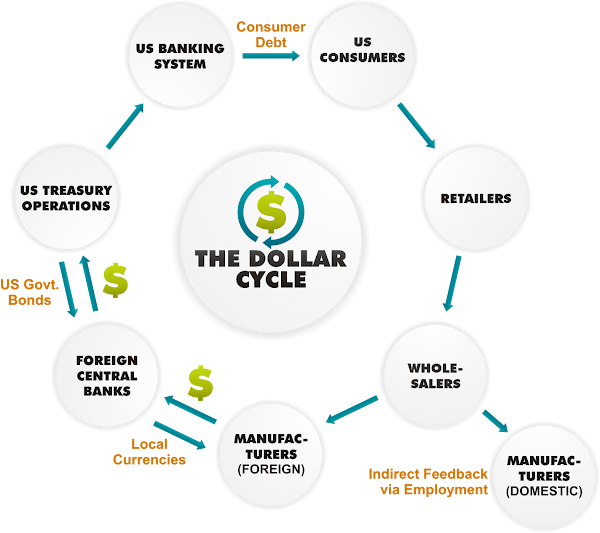traderkenny
Active member
- Messages
- 106
- Likes
- 4
The Learn About Futures Insider:
US Dollar Index
US Dollar Index
Since the dawn of commerce and trade, currency has evolved to facilitate the process by providing a medium of exchange and helping people represent a store of value. The circulating medium, whether coins or paper money, was developed in many cultures. The U.S. dollar is a globally recognized hard currency. The U.S. Dollar Index is a measure of the value of the U.S. dollar against six major world currencies using a weighted geometric mean. U.S. Dollar Index futures are traded on the Intercontinental Exchange (ICE) and the CME, but for this lesson, specifications will refer to the ICE contract.
Contract Size:$1,000 x Index Value
Price Quote & Tick Size:US Dollar Index points, calculated to three decimal places .010 = $10; minimum tick size is .005 = $5 per contract
Contract Months: March, June, September, December
Trading Specs: Electronic Trading Hours 8:00 pm to 6:00 pm the following day on the Intercontinental Exchange (Sun - Fri) *the trading platform is available 30 minutes before the opening for order entry. Open on Sunday night is 6:00 PM ET; Pre-Open at 5:30 PM ET
Daily Price Limit: None
Trading Symbols: DX

Past performance is not indicative of future results.
***chart courtesy of Gecko Software
US Dollar Index Facts
The level of the U.S. Dollar Index indicates the average value of the dollar relative to the agreed 1973 base of 100.00, when major trading nations agreed to allow their currencies to float freely against each other. It is computed using the weighted average of currencies with a highly developed market.
The current basket of currencies used to calculate the U.S. Dollar index includes twenty countries: the fifteen nations in the Euro Zone and five other countries who make up the basis of global trade with the United States. The currencies and their relative weights are as follows:



Key Terms
Hard Currency - This term refers to a currency which is traded around the world and is seen as a stable store of value. This perception is usually based on the issuing country's policies and its economic and political situation.
Quantitative Easing - Refers to a monetary policy which increases the money supply when the central bank buys securities and then infuses financial institutions with capital. The risks associated with this kind of policy include the possibility of hyper-inflation and devaluing the dollar.
Trade Weighted Dollar Index - An index created by the Federal Reserve that is a weighted average of a large number of currencies, far more than the ICE US Dollar Index. This index was created following the introduction of the euro.
Key Uses
Besides the obvious implications and uses for currency, the U.S. Dollar Index has investing applications as well. As a financial instrument, U.S. Dollar Index futures are often used as a means to hedge currency exchange risk. Since the U.S. dollar is such a huge part of international trade, this can be a significant market for other businesses as well.
Key Concerns
Several factors within a nation can have a significant effect on the currency exchange rates and the relative importance of each is the subject of debate, however, it is important to be aware of some of the key fundamentals.
Inflation - It is generally believed that countries with consistently lower inflation exhibit a rising currency value while countries with higher inflation may see currency depreciation.
Interest Rates - High interest rates may attract foreign investors and that can lead to an exchange rate increase while the opposite scenario is possible in a country with low interest rates.
Overall Economic Conditions - Everything from a country's balance of trade to the size of their deficit or surplus can serve as a barometer of the condition of the country and the likelihood of default. Investors look for countries with stronger economic foundations and the better the economic foundation of one country versus another may increase the value of the country's currency.
Perception - The so called "flight to quality" exists within foreign currencies as investors will often seek what they perceive as "safe haven" currencies during times of political or economical instability.
_______________________________________________________________________________________
Disclaimer: There is a substantial risk of loss in futures trading and it is not suitable for all investors. Losses can exceed your account size and/or margin requirements. Commodities trading can be extremely risky and is not for everyone. Some trading strategies have unlimited risk. Educate yourself on the risks and rewards of such investing prior to trading. Futures Press Inc., the publisher, and/or its affiliates, staff or anyone associated with Futures Press, Inc. or www.learnaboutfutures.com, do not guarantee profits or pre-determined loss points, and are not held monetarily responsible for the trading losses of others (subscribers or otherwise). Past results are by no means indicative of potential future returns. Fundamental factors, seasonal and weather trends, and current events may have already been factored into the markets. Options DO NOT necessarily move lock step with the underlying futures contract. Information provided is compiled by sources believed to be reliable. Futures Press, Inc., and/or its principals, assume no responsibility for any errors or omissions as the information may not be complete or events may have been cancelled or rescheduled. Any copy, reprint, broadcast or distribution of this report of any kind is prohibited without the expressed written consent of Futures Press, Inc.
